More Magyar: Marhapörkölt nokedlivel (Goulash w/ spaetzle)
More Magyar: Marhapörkölt nokedlivel (Goulash w/ spaetzle)
-
-
-
-
-
More Magyar: Marhapörkölt nokedlivel (Goulash w/ spaetzle)
-
Post #1 - February 5th, 2008, 1:47 amA couple of folks have asked for galuska/nokedli/spaetzle making instruction, so I decided to team this up with a recipe for the classic Hungarian stew called pörkölt, spefically beef (marha) pörkölt.
Now, that which Hungarians call gulyás is actually a hearty soup comprised mainly of beef, onions, paprika, soup veggies, and potatoes. What we (and the Germans and Austrians) know as "goulash/goulasch" goes by the name of pörkölt in the Magyar tongue. Hungarians do like their stews, and there are three basic types: pörkölt, paprikás, and tokány. Generally, all three contain generous amounts of meat and onion. Pörkolt and paprikás are flavored with paprika, and paprikás is basically a pörkölt with sour cream added to it. The third, tokány, originates in Transylvania and is generally made without paprika and is flavored with spices and herbs such as black pepper, marjoram, etc. There are other minor details that differentiate the three, but those are the basic points.
On to marhapörkölt:

Caraway seeds, paprika, banana peppers, lard, onion, tomato paste, garlic, stewing beef
I started with two pounds of boneless short ribs cut into cubes. Leg or shoulder cuts are what usually were used in Hungary, but I just love the flavor and texture of short ribs. However, any stewing or braising cut will do.
Normally, one starts with the onions and lard in Hungarian cooking, but I started off by browning my meat in the lard in two batches:
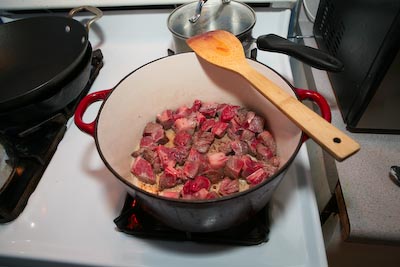
After removing the meat, add a finely diced large onion. When it becomes translucent, remove from heat (or set to lowest setting) and add a couple heaping teaspoons of sweet (or mix of sweet and hot) paprika. As in the paprikash thread, much of the success depends on the quality of paprika, so, at a minimum, use something like Pride of Szeged sweet paprika. I find that sweet paprika has more flavor and aroma to me, so I almost always use nothing but sweet paprika in my Hungarian cooking, and add heat later at the table if desired.
Add two finely chopped Hungarian wax/banana peppers, a clove or two of garlic (if desired, it's not necessary), a teaspoon or two of caraway (recipes generally call for ground, but I use whole. This is also an optional ingredient). Also, if you have fresh tomatoes available, one chopped whole fresh tomato can go in at this point, but I added a heaping tablespoon or two of tomato paste instead. If you happen to have lecsó/lecho/letscho in a jar somewhere, you can use it instead of the peppers and tomatoes:

Mix thoroughly and add browned meat:
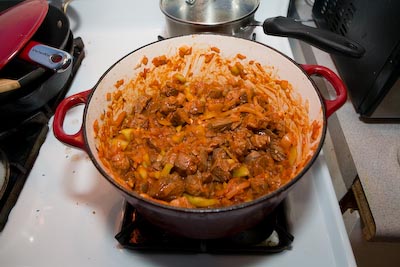
Now, just like with the paprikash, you will be adding minimal liquid. You can certainly use red wine if you wish, but I just added 1/2 cup of water to keep things moist and avoid burning. Trust the onions and meat to release enough juices to make a very rich stew. Generously salt the stew and turn the heat down to the lowest setting, cover, and let sit for about 2 hours or more.
Now for the spaetzle:
When your pörkölt is almost ready, it's time to make the perfect accompaniment, galuska/nokedli (egg dumplings). They are very similar to German spaetzle. Here's what you need:
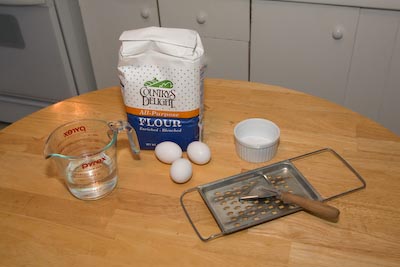
About one cup water, flour, three large eggs, salt, a galuska maker. Now, if you don't have a galuska maker lying about, don't fear, as a cheese grater with holes about the size of a pencil will work just as well.
Beat the eggs, water, and a teaspoon or so of salt together:

Now, add enough flour and mix to get the consistency of a very thick pancake batter. I used about 3 to 3 1/2 cups of flour. You're looking for a batter that's thick enough to stick to your fork, but with enough liquid so that it does slowly drip down:
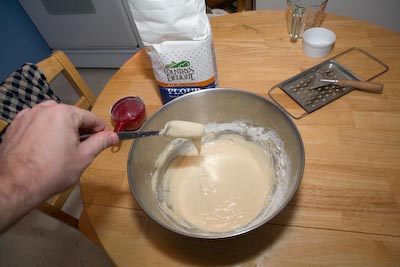
Bring a pot of generously salted water to a boil. Place your spaetzle maker across the top, scoop a cup of batter onto it, and rake through. If using a cheese grater, do your best with a wooden spoon.
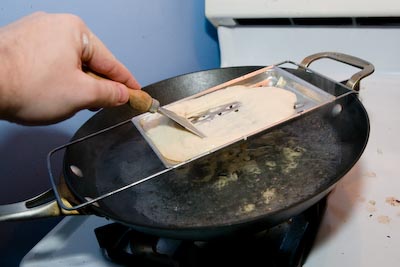

Galuska are ready when they float to the top, but you don't have to be too concerned about overcooking them. Scoop up and strain when finished.
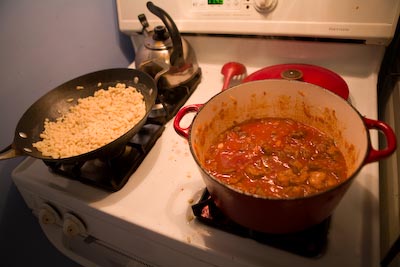
Look how much juice rendered out of the beef and vegetables! No need to add stock or anything. Just pure beef and onion-y goodness.
Serve and garnish with banana peppers:
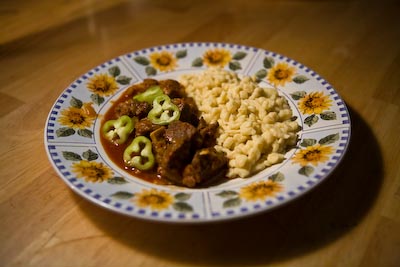
-
-
Post #2 - February 5th, 2008, 6:53 amWhen making the nokedli, did you make them in batches, or just continue to crowd the pot as long as the water is boiling?
Your dish looks delicious.
I'm a big fan of Hungarian foods that are heavy with paprika. I make what you described as "gulays" a few times per winter. I usually get my different paprikas at Penzey's spices and think they are very flavorful.
-
-
Post #3 - February 5th, 2008, 7:50 amYou are officially the best at making a recipe seem "do-able"! Question: I love in Niles and where would I get the right type of paprika? And where so I get a brick that says LARD! Would a brick of Crisco work? I was telling my dad about the pics of the chicken dish and he was so excited. He said Grandma made alot of Hungarian dishes because her mom was actually born and came here from Transylvania. So I learned something new about my heritage!The clown is down!
-
-
Post #4 - February 5th, 2008, 8:16 amThanks for the spaetzle recipe. I'll have to try it with the goulash I have in my freezer
 I can't believe I ate the whole thing!
I can't believe I ate the whole thing!
-
-
Post #5 - February 5th, 2008, 10:50 amJeanneBean wrote:You are officially the best at making a recipe seem "do-able"! Question: I love in Niles and where would I get the right type of paprika? And where so I get a brick that says LARD! Would a brick of Crisco work? I was telling my dad about the pics of the chicken dish and he was so excited. He said Grandma made alot of Hungarian dishes because her mom was actually born and came here from Transylvania. So I learned something new about my heritage!
There is a Bende up in Vernon Hills where you could get Paprika at. Otherwise if you have a good spice merchant in your area you could probably try there.
I'm a southsider so I don't know where to suggest you go in your area for the brick o' Lard. The last time I purchased some I got mine at the Bobak's on Pulaski in Chicago.
Bende
925 Corporate Woods Pkwy
Vernon Hills, IL
60061
847-913-0306.
-
-
Post #6 - February 5th, 2008, 11:14 amJeanneBean wrote:You are officially the best at making a recipe seem "do-able"! Question: I love in Niles and where would I get the right type of paprika? And where so I get a brick that says LARD! Would a brick of Crisco work? I was telling my dad about the pics of the chicken dish and he was so excited. He said Grandma made alot of Hungarian dishes because her mom was actually born and came here from Transylvania. So I learned something new about my heritage!
Around here (Southwest Side), you can find Pride of Szeged paprika pretty much at any grocery store. Jewel and Dominick's all have it. If you want to go a little better, try looking for Hungarian Sweet Kulonleges Paprika at Penzey's spices. And, as mentioned above, Bende is a great source for all things Hungarian.
As for the lard, you can use vegetable oil if you wish. Traditionally, lard is used for the extra flavor it adds, but it is not unusual to find today's Budapester using sunflower oil instead. Anyhow, lard should also be available in pretty much any grocery store (although I have been in places where it's surprisingly difficult to find). I bought mine at a place called Pete's Market.
-
-
Post #7 - February 5th, 2008, 11:31 ambrandon_w wrote:When making the nokedli, did you make them in batches, or just continue to crowd the pot as long as the water is boiling?
Your dish looks delicious.
I'm a big fan of Hungarian foods that are heavy with paprika. I make what you described as "gulays" a few times per winter. I usually get my different paprikas at Penzey's spices and think they are very flavorful.
I made the nokedli in two batches. Also, I don't normally make them in a wok of boiling water, but I left my big pot at my girlfriend's, and that was the second largest vessel I could find.
Your comment about gulyás reminded me, add a bunch of water and some soup veggies to the pörkölt and you have gulyás. I'll do a gulyás recipe at some point, but I'll want to take a slightly different direction for the next recipe.
-
-
Post #8 - November 17th, 2009, 3:36 pmI just wanted to add a couple more tips for the galuska/spaetzle, in case anybody refers to this recipe. I've recently began using soda water instead of regular water for the spaetzle to make them a little fluffier and lighter. This a trick I borrowed from Hungarian crepe recipes (palacsinta), which often have soda water in the batter. And you generally want to keep the ratio of flour to egg as one extra large egg to one cup flour. With this ratio, the amount of liquid should be around a scant 1/2 cup water (about 3/8 cup) for ballpark correct consistency. Also let the dough rest 5-10 minutes before boiling so it hydrates properly.
-
-
Post #9 - November 17th, 2009, 3:44 pmMy mother used seltzer for her nokedli. And she had a cooler nokedli maker; it had a conical hopper which ran on a track outside the part with the holes in it. She just slid it back and forth and it deposited a perfect little dollop with every slide.
-
-
Post #10 - November 17th, 2009, 5:12 pmBinko - great looking bowl of porkolt. My Hungarian mother makes her nokedli much the same way, though the use of seltzer water is new to me.
One minor quibble - and there certainly isn't one way to make porkolt, but I would omit tomato paste/tomato. If only because many my family and Magyar friends have always insisted that it doesn't belong anywhere near porkolt or paprikas. My porkolt/paprikas sauce is built on a sturdy base of onion onion onion and paprika paprika paprika.
You might object to this little twist though - we use (gasp) olive oil almost exclusively in my house. Even for Magyar food. I know, sin. Chalk it up to the fact that if there is a Palestinian in the house (my pops) its olive oil or nuthin.
Cheers for posting the great pics. We need to boost the Magyar resources on LTH.
jo etvagyat!
Hungarian Habibi"By the fig, the olive..." Surat Al-Teen, Mecca 95:1"
-
-
Post #11 - November 17th, 2009, 5:36 pmHabibi wrote:One minor quibble - and there certainly isn't one way to make porkolt, but I would omit tomato paste/tomato. If only because many my family and Magyar friends have always insisted that it doesn't belong anywhere near porkolt or paprikas. My porkolt/paprikas sauce is built on a sturdy base of onion onion onion and paprika paprika paprika.
I should have mentioned that it is, indeed, an optional ingredient and there is some controversy over whether it is "acceptable" or not. I tend to use it about half the time I make it, and always in the form of tomato paste. Before I wrote up the recipe, I consulted this Hungarian recipe depository to research some variations. Somewhat surprisingly, the large majority of the recipes there call for tomato, and quite often fresh tomato, so I wanted to hedge my bets and leave it in. The way I was taught is to never thicken porkolt with flour, but to use tomato paste if it's a little thinner than you want it to be, or omit it all together if your consistency is good. I believe the Gundel cookbook also calls for tomato in the porkolt, and my Culinaria Hungary (which is good source for authentic recipes, too) does as well. That said, as you note, there's not one way to make a porkolt and I'm more than happy to omit tomato from the recipe.
I whole-heartedly agree that tomato is jarring in paprikash, and in the paprikash recipe I've posted here on LTH I make a note of the optional tomato and my personal feelings on it, but, once again, even my Gundel Hungarian cookbook calls for tomato. Truth be told, every time I was served chicken or veal paprikash in Hungary (and it's been a lot), I can't remember ever finding a tomato product in it.
I'm thinking of what recipe to post next in the Hungarian kitchen series. There's a nice paprika cheese spread (körözött) which anyone who has been to The Epicurean Hungarian in Hillside has encountered, which is pretty easy to make, and is a hit at parties. I just need to get my camera out.
Oh, and this beef porkolt recipe can just as easily be made with any good stewing cut of pork, lamb/mutton, or even chicken. In other words, any protein suitable for stewing will work.Last edited by Binko on November 17th, 2009, 5:44 pm, edited 1 time in total.
-
-
Post #12 - November 17th, 2009, 5:42 pmspinynorman99 wrote:My mother used seltzer for her nokedli. And she had a cooler nokedli maker; it had a conical hopper which ran on a track outside the part with the holes in it. She just slid it back and forth and it deposited a perfect little dollop with every slide.
I know of the one. Looks like this, right? It is pretty neat.
-
-
Post #13 - November 17th, 2009, 7:18 pmI know of the one. Looks like this, right? It is pretty neat.
Indeed. Hers had a metal hopper (it's also about 30 years old).
-
-
Post #14 - November 17th, 2009, 10:08 pmHi,
I have that hopper style as well as another that looks like a giant garlic press. My Oma used the garlic press, though over the years I have come to favor the hopper. I like the heavier dumpling from the hopper.
Regards,Cathy2
"You'll be remembered long after you're dead if you make good gravy, mashed potatoes and biscuits." -- Nathalie Dupree
Facebook, Twitter, Greater Midwest Foodways, Road Food 2012: Podcast
-
-
Post #15 - November 17th, 2009, 11:36 pmYeah, the hopper style and the rake style make the little teardrop-shaped dumplings. The garlic press one (if I'm thinking of the right contraption--it also reminds me also of a potato ricer) is the one that makes the more noodle-like spaetzle, right? Like the come out in strands rather than balls? Or am I thinking of something else? If so, then I've only seen that in German cookery, but not in Hungarian. The Hungarian version of spaetzle always comes in those little teardrop shapes, so far as I've seen.
At any rate, it's starchy goodness either way.
-
-
Post #16 - November 18th, 2009, 11:15 pmHi,
The garlic press (yes, it could be called a ricer) is trickier to deal with. If you press in one continuous motion, it comes out in strings but breaks up in the water. My Oma got teardrop looking spaetzle out of i. I estimate she kept her dough thick. I've done thinner and thicker doughs, a full pull or stacatto with no uniform result. Once I started using the hopper, I was much happier with my spaetzle and consistent.
I keep the garlic press style one because of my Oma. It's also fairly expensive priced new at $40 and up. The hopper I've seen at $10.
Regards,Cathy2
"You'll be remembered long after you're dead if you make good gravy, mashed potatoes and biscuits." -- Nathalie Dupree
Facebook, Twitter, Greater Midwest Foodways, Road Food 2012: Podcast
-
-
Post #17 - November 15th, 2013, 11:00 amI need to find a good Hungarian cookbook as a gift. George Lang is well known and his book seems to be popular. Can anyone help?"I feel sorry for people who don't drink. When they wake up in the morning, that's as good as they're going to feel all day." Frank Sinatra
-
-
Post #18 - November 15th, 2013, 11:08 amHi,
There is a woman in Deerfield, IL who has a website on Hungarian recipes and published a book: June Meyer's Authentic Hungarian Heirloom Recipes website, which has an index and links to all her recipes.
Binko who has authored a number of Hungarian cooking threads on this board has often used her website.
Regards,Cathy2
"You'll be remembered long after you're dead if you make good gravy, mashed potatoes and biscuits." -- Nathalie Dupree
Facebook, Twitter, Greater Midwest Foodways, Road Food 2012: Podcast
-
-
Post #19 - November 15th, 2013, 7:01 pmCathy2 wrote:Hi,
There is a woman in Deerfield, IL who has a website on Hungarian recipes and published a book: June Meyer's Authentic Hungarian Heirloom Recipes website, which has an index and links to all her recipes.
Binko who has authored a number of Hungarian cooking threads on this board has often used her website.
Regards,
June Meyer is great. I didn't realize she was in Deerfield, how cool. Or if you happened to mention it, I must have forgotten. (And I say this because I have this nagging feeling that this has been mentioned here before, and I have some vague recollection, but I don't trust my memory.)
I also like this one a lot. Beautiful photos, solid recipes, great insight into the feel of the country.
-
-
Post #20 - November 16th, 2013, 9:37 amLooks great and now I am hungry. Binko you cook very similarly to how I cook except I am a greater fan of tomatoes and green peppers in my food prolly because that is what I am familiar with.Toria
"I like this place and willingly could waste my time in it" - As You Like It,
W. Shakespeare
-
-
Post #21 - November 16th, 2013, 10:10 amOh, I love tomatoes and peppers! You should see my lecsó recipe.
 I just don't use them a lot in these stews.
I just don't use them a lot in these stews.
-
-
Post #22 - November 23rd, 2013, 2:29 pmThanks for this recipe, Binko. I made it recently, and I have to say that it turned out to be one of those dishes that is WAY more than the sum of its parts. Absolutely delicious.Man : I can't understand how a poet like you can eat that stuff.
T. S. Eliot: Ah, but you're not a poet.
-
-
Post #23 - November 24th, 2013, 6:30 amRevrendAndy wrote:I need to find a good Hungarian cookbook as a gift. George Lang is well known and his book seems to be popular. Can anyone help?
My own answer would be that this is a fine place to start: it's not only a cookbook but has a fair amount of other cultural and related history as well. Lang's recipes are fairly standard and almost always reliable. I have a relatively large number of Hungarian (and Romanian) cookbooks, but I find that I often start with Lang and then see how others vary. While I'm sure others may have their favorites, I'd be surprised if anyone would recommend against Lang.
(FWIW, Binko's recommendation of the Culinaria volume on Hungary is also spot-on and if you're looking for a great cookbook that can also double as a coffee-table book, this is it!)Gypsy Boy
"I am not a glutton--I am an explorer of food." (Erma Bombeck)
-
-
Post #24 - November 25th, 2013, 11:09 amThanks for the help. I decided to go with Lang. It looks like a good choice."I feel sorry for people who don't drink. When they wake up in the morning, that's as good as they're going to feel all day." Frank Sinatra
-
-
Post #25 - October 3rd, 2016, 5:21 pmComing back to this thread for a great fall dish. And in re-reading, I am now noticing the tips on spaetzle. After having Cathy2's delicious family favorite, spaetzle with sauerkraut and Vienna sausages some years back, I invested in a spaetzle maker. I intend to make good use of it tomorrow evening. Thanks, Binko for a great recipe. I make it with pork.Man : I can't understand how a poet like you can eat that stuff.
T. S. Eliot: Ah, but you're not a poet.
-
-
Post #26 - October 6th, 2016, 2:04 pmJosephine,
Which type of spaetzle maker did you get: shuttle or press?
I own both, though I prefer the shuttle.
Regards,
Cathy2Cathy2
"You'll be remembered long after you're dead if you make good gravy, mashed potatoes and biscuits." -- Nathalie Dupree
Facebook, Twitter, Greater Midwest Foodways, Road Food 2012: Podcast
-
-
Post #27 - October 6th, 2016, 2:45 pmI made the goulash a couple nights ago with pork stew meat instead - so delicious, thanks Binko!Logan: Come on, everybody, wang chung tonight! What? Everybody, wang chung tonight! Wang chung, or I'll kick your ass!
-
-
Post #28 - October 6th, 2016, 3:04 pmYou're welcome. Glad to see this recipe has some legs! It doesn't look like I mentioned it in my original recipe, but any stewing meat can be used (except that the name changes). In Hungary, it is common to make it with pork (sertéspörkölt) and less often with lamb (báránypörkölt) and even chicken (csirkepörkölt, which I do believe I mention in my chicken paprikash recipe.)
Oh, and there's also catfish (hárcsapörkölt). Obviously adjust cooking times for the meat you are using. Catfish should only take about 10-15 minutes. Chicken maybe an hour or so.

